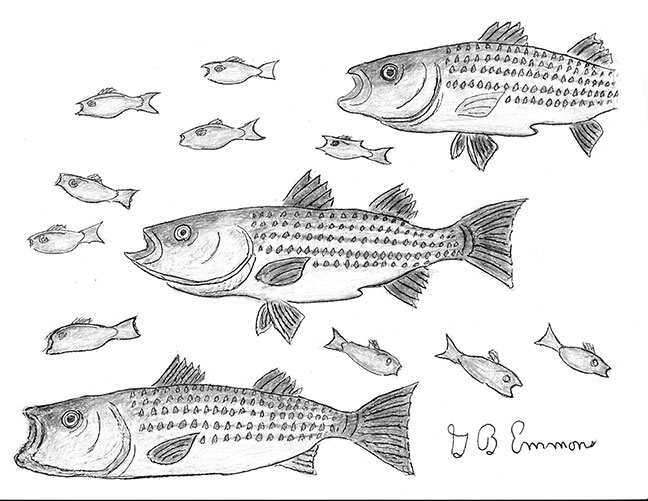The striped bass, affectionately called a striper for the dark lines along its side by sportsmen, prefers a water temperature from 55 degrees to 68 degrees. To stay in this range, they migrate both in spring and fall. With the arrival of summer, the spring migration is all but complete in Buzzards Bay, having started more than a month ago from distant winter quarters down south. They soon pass up along the coastlines of North Carolina and Virginia, where they then detour into the Chesapeake Bay, and finally the Delaware, Hudson, and Connecticut Rivers to spawn.
The stripers are labeled anadromous by spawning in brackish or fresh water. After spawning, they school up into moving formation, as in my illustration. They head up along the Atlantic coast to eventually pass through the Cape Cod Canal into Massachusetts Bay toward northern New England for the summer.
Sport fishing for stripers is very popular, and they are the state fish in Virginia, Maryland, New Jersey, Rhode Island, and New Hampshire. Their natural history dates back to colonial days of gratitude for their legions swimming up coastal rivers with alewives and shad. They were seen as a godsend to hungry settlers and famished troops at Valley Forge. However, annual overfishing took place into the start of the last century, and now several hundred years later, the numbers have sadly declined to a mere 5 million stripers.
In 1982, Atlantic States Marine Fisheries reacted by making them a protected game fish and imposed the current 29-inch keeper requirement. Fortunately, a ban was also imposed prohibiting harvesting beyond the 3-mile coastal limit. Within just 10 years, the population was remarkably back to 56 million, with about 3.8 million annually taken for sport fishing.
The largest striped bass ever taken on light tackle was 81 pounds and 4 feet in length. The striped bass has a mild, but firm flavorful flesh with a large flake when eaten. It is popular when pan seared, steamed, poached, sautéed, or roasted, but especially when grilled outdoors, making it a gourmet ritual in coastal communities like Buzzards Bay. Commercial demand is so much that they have been hybridized with a commercial common white bass, known as a wiper. It was stocked experimentally in lakes and rivers across the country. Once inland, natural population could be verified as successfully landlocked. However, an observable diminution of spawning activity meant that regular reproduction levels must be stocked by hatcheries.
The fall migration of stripers south will not begin for another two months. As in the 1950’s end of summer popular song “… the days get short when you reach September,“ we will then witnesses a seasonal ebb tide motion of migrating songbirds, waterfowl, ospreys, hummingbirds, and butterflies. This movement will also be shadowed underwater by stripers on the move. As the water cools, they are anxious to fatten up on baitfish such as peanut bunkers and silversides. We look for gulls diving down on blitzing bait pods that come in with a rising tide. Striper fall migration extends into late October and from our window on Little Bay, it is a very entertaining seasonal curtain call of a stripe bass migration performance.
By George B. Emmons
